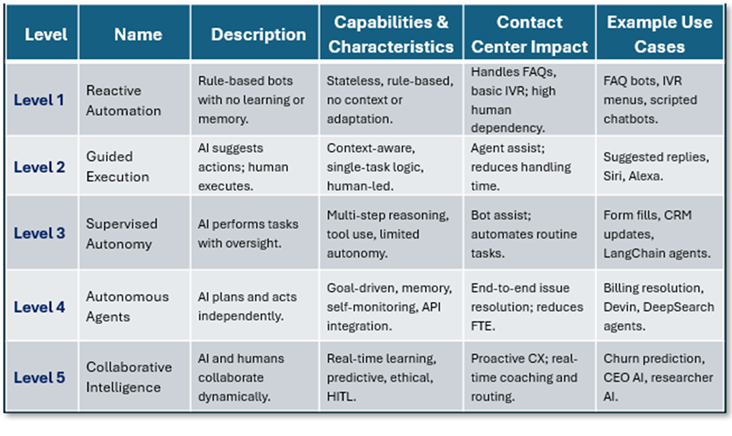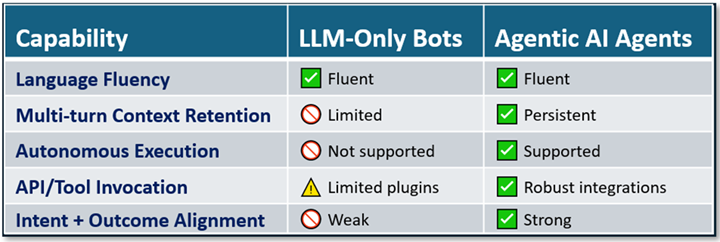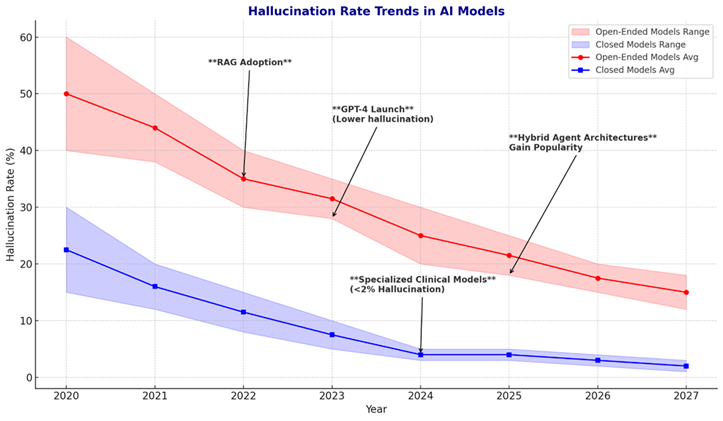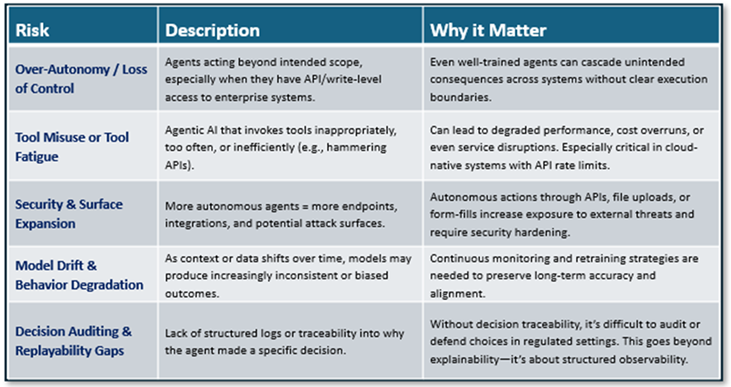The Shift from Reaction to Initiative: Welcome to the Agentic Era
Picture this: A customer contacts support after spotting a suspicious charge. Instead of repeating their story three times, waiting on hold, or getting passed between departments, they’re greeted by an intelligent system that’s already identified the issue, reviewed their history, initiated a refund, and confirmed resolution — all without human involvement.
That’s not a vision of the distant future. It’s the emerging reality of Agentic AI.
As organizations move beyond scripted bots, keyword-driven automation, and task-specific virtual agents, a new type of AI is taking shape — one that doesn’t just wait for instructions but acts with intent. Agentic AI refers to systems capable of pursuing goals, making autonomous decisions, and coordinating actions across tools, systems, and channels. These agents operate more like collaborators than tools: they plan, learn, adapt, and execute — transforming how work gets done in the contact center.
This shift isn’t about replacing people. It’s about elevating them — freeing human agents from repetitive tasks and enabling them to focus on empathy, nuance, and judgment. It’s about moving from reactive service to proactive engagement, and from scripted interactions to autonomous resolution.
In this blog, we explore what Agentic AI truly is (and isn’t), why it matters now, and how it’s reshaping the future of customer experience — starting in the contact center.
The term “Agentic AI” was coined by Andrew NG just over a year ago (mid-2024), but specifics around its meaning, how it can be applied and other implications are still taking shape. There’s continued debate about where the boundary lies between traditional automation and true agency. To understand what Agentic AI is, we must first understand what it means to have agency.
For people, it means to possess the capacity to act independently, make your own choices, and exert influence or control over your environment or circumstances.
“The best way to predict the future is to create it.” – Peter Drucker
When a person has an agency, they are responsible for deciding what actions to take. They initiate actions and behaviors rather than reacting or following a request. They own the consequences of their decisions, and thus take other actions as a result of those consequences. Having an Agency is what allows individuals to shape their environment rather than simply respond to it. Agency is not just action; it’s intentional action, driven by goals. When we extend this concept to AI, we begin to see what makes Agentic systems different.
“Agentic AI refers to systems that have agency, the ability to act autonomously, initiate actions, make context-driven decisions pursuing goals and execute tasks across multiple steps to achieve larger goals and initiatives. Most importantly, to take on these tasks with minimal or no human intervention.”
So why is there still so much confusion about what qualifies as Agentic AI?
Much of the uncertainty stems from differing interpretations of how much autonomy a system must exhibit to be considered truly agentic. This ambiguity is reminiscent of the early days of autonomous vehicles, when the industry lacked a shared vocabulary to distinguish between driver-assist features and full autonomy.
Today, AI faces a similar challenge. While the concept of agency is becoming clearer, the levels of initiative, planning, and decision-making vary widely between implementations. To address this, a five-level maturity model has begun to take shape; very similar to the five-level classifiers used for autonomous driving vehicles. This five-level system being used for AI provides a structured way to classify Agentic AI systems by their capabilities, impact, and degree of autonomy.
From Scripts to Autonomy: Why Agentic AI Matters Now
So Why Now? For years, contact centers have operated within the constraints of rule-based IVRs, scripted interactions, and bots designed to handle only the most routine queries. These systems, while sufficient for high-volume, low-complexity needs - were never intended to manage nuance, intent, or the growing demand for personalized, real-time service.
Agentic AI represents a leap forward. Unlike traditional automation that simply responds on cue, Agentic systems detect goals, plan actions, and execute complex workflows independently. They’re not just reactive; they initiate, adapt, and collaborate across channels and systems.
This shift is more than technical—it’s strategic. Agentic AI enables a new era of customer engagement, where automation becomes not just more capable, but more contextually intelligent. And its rise isn’t theoretical. It’s being accelerated by real-world forces that make enterprise adoption not only possible, but urgent.
Unlike conventional bots, or even modern LLM-based assistants that rely on prompt-response logic - Agentic AI systems take initiative. They learn over time, manage multi-step tasks, and adapt to real-world conditions. In the contact center, that means AI no longer waits to be told what to do. It detects intent, evaluates context, and executes on behalf of the customer or the agent.
This isn’t a minor upgrade. It’s a fundamental leap from automation as a tool, to automation as a teammate.
As we enter this new phase, Agentic AI stands not at the edge of possibility, but at the center of how customer experience will be defined in the coming years.
Catalysts Accelerating the Rise of Agentic AI
Several key factors have converged to make Agentic AI a practical—and urgent—priority for enterprises:
1. The Maturation of Foundation Models: Advances in LLMs like GPT-4, Claude, and Gemini have moved AI beyond clever text generation. These models now demonstrate reasoning, memory, and contextual fluency—laying the groundwork for goal-driven, autonomous systems.
2. Orchestration that Bridges Silos: Modern orchestration layers now enable AI agents to interact across disparate systems—APIs, databases, CRMs, and workflows—allowing them to execute real tasks in real environments, not just simulate conversation.
3. The Experience Gap is Growing: Consumers today expect fast, personalized, 24/7 service. They have little patience for bots that deflect or loop them through scripted flows. Agentic AI is designed to meet this expectation, acting in real time with context and initiative.
4. The Pressure to Scale Intelligently: Contact centers face ongoing pressure to improve efficiency without increasing headcount. Agentic AI enables organizations to expand service capacity while allowing human agents to focus on high-value, empathetic interactions.
5. Global Complexity Requires Smarter Automation: Operating across geographies, languages, and time zones demands adaptable systems. Agentic AI’s multilingual, cross-cultural capabilities make it uniquely positioned to handle this complexity at scale.
Agentic AI vs. LLM-Only Systems: The Critical Difference
Large Language Models (LLMs) have redefined how machines understand and generate human language. But language fluency alone isn't enough for enterprise-grade automation.
While LLMs can converse, summarize, and even reason within a single thread, they fall short when it comes to autonomy, memory, and real-world action. That’s where Agentic AI steps in, building on LLM capabilities and extending them with planning, memory, tool use, and autonomous execution.
Limitations of LLM-Only Systems:
● Fluent in conversation but lack continuity across sessions.
● Limited ability to reason through multi-step tasks or long-term task management.
● Cannot independently take action in enterprise environments.
● Dependent on human or external triggers for meaningful execution.
Strengths of Agentic AI:
● Built on LLMs but equipped with decision engines and memory layers.
● Capable of maintaining stateful memory for continuity and personalization.
● Prioritize and execute complex, real-world workflows across CRMs, APIs, and tools without supervision.
● Deliver outcomes, not just responses.
Bottom Line: LLMs help machines understand and comprehend language and intent. Agentic AI helps them use that understanding to act, independently, intelligently, and at scale. It’s the difference between answering questions and solving problems.
The Mphasis Approach: Operationalizing Agentic AI
Agentic AI shouldn’t just respond - it should reason, act, and adapt, while still operating within the enterprise’s framework for control, governance, and trust.
At Mphasis, this philosophy aligns closely with our Straight Through Processing (STP) methodology, where intelligent automation flows across the full customer journey—minimizing friction, eliminating manual handoffs, and accelerating meaningful outcomes.
Balanced AI with Human-in-the-Loop (HITL)
But autonomy doesn’t mean a lack of oversight. We advocate for a Balanced AI Model, where Agentic systems are empowered to act independently, but humans remain in the loop at critical decision points. This ensures responsible deployment, ethical alignment, and regulatory compliance—particularly vital in high-stakes or customer-sensitive environments.
Core Elements of the Mphasis Agentic AI Strategy
• Proprietary Agentic Frameworks: Purpose-built agents designed to autonomously handle complex service journeys—across voice, chat, email, and digital channels.
• Real-Time Orchestration Engines: AI agents dynamically coordinate APIs, enterprise data, customer profiles, and historical context to drive timely, context-aware decisions.
• Advanced Intent & NLU Engines: High-accuracy natural language understanding enables personalized service, rapid issue resolution, and deeper insight into customer goals.
• Strategic Platform Ecosystem Partnerships: Collaborations with AWS, Azure, Google Cloud, Salesforce, Kore.ai, and CCaaS leaders ensure flexibility and enterprise-grade scalability.
Our approach empowers enterprises to deploy Agentic AI architectures at scale and operationalize them with confidence -combining innovation with governance, accelerating outcomes while maintaining oversight, and balancing autonomy with accountability.
Real-World Case Study: Tier-1 Banking CX Transformation
The Challenge:
A global Tier-1 bank was facing mounting pressure across its customer support operations:
● High call volumes were overwhelming human agents.
● Long wait times were eroding customer satisfaction, leading to customer frustration.
● Fragmented multilingual support was failing to meet global customer expectations.
The Solution:
Mphasis deployed its Agentic AI platform to automate Tier-1 service requests across both voice and digital channels. The solution was deeply integrated with the bank’s back-end systems, enabling autonomous agents to handle end-to-end workflows—across languages, channels, and customer intents.
The Results
The impact was both immediate and measurable:
• 20+ Languages Supported: Delivering consistent, always-on global engagement.
• 40% Reduction in Escalations: Agentic AI resolved a significant share of interactions without human intervention.
• 35% Decrease in Average Handling Time (AHT): Faster resolutions translated into efficiency gains and improved CX, and increased EX satisfaction as well .
• Significant CSAT & NPS Uplift: Customers experienced faster, more intelligent support, while agents were freed to focus on higher-value, advisory conversations.
This deployment illustrates how Agentic AI doesn’t just automate tasks, it transforms both the customer experience (CX) and employee experience (EX), resulting for a better unified experience (UX) - delivering tangible results across operational, experiential, and strategic dimensions.
Future Outlook: Agentic AI and the Intelligent Enterprise
The contact center of the future will be unrecognizable from its legacy counterpart. No longer reactive service hubs, they will evolve into AI-first ecosystems, where Agentic systems and human advisors collaborate seamlessly to deliver intelligent, adaptive, and empathetic customer experiences.
The following trends signal how Agentic AI is set to reshape enterprise operations:
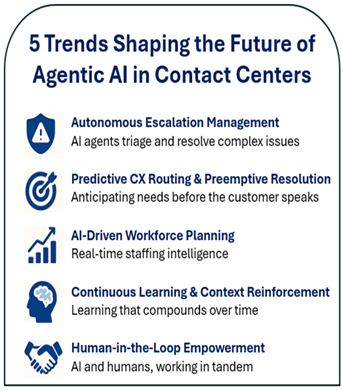
|
1. Autonomous Escalation Management
AI agents will increasingly manage complex inquiries end-to-end—triaging issues, navigating decision trees, and resolving cases with minimal human involvement.
2. Predictive CX Routing and Preemptive Resolution
Armed with behavioral insights and predictive models, Agentic systems will anticipate customer needs before they’re expressed—deflecting issues and routing tasks based on intent, urgency, and value.
3. AI-Driven Workforce Planning
From forecasting volume spikes to optimizing agent skill allocation, intelligent systems will refine workforce strategies in real time—improving both staffing efficiency and service quality.
4. Continuous Learning and Context Reinforcement
Agentic AI will not only learn from each interaction—it will retain and build upon context, offering agents smarter recommendations and customers more seamless, personalized journeys over time.
5. Human-in-the-Loop (HITL) Empowerment
Even as back-end tasks are fully automated, human agents will play a vital role in governance, ethical alignment, and complex decision-making—ensuring a hybrid model where automation enhances, rather than replaces, human contribution.
Risks and Considerations: Deploying Agentic AI Responsibly
While Agentic AI holds transformative potential, responsible deployment demands clear guardrails. Enterprises must anticipate and mitigate the following risks to ensure secure, ethical, and effective implementation:
Hallucination and Accuracy Risks
Not all AI outputs are grounded in fact. Foundation models trained on broad internet datasets—such as GPT-4, Claude, or Gemini—can occasionally generate speculative or incorrect responses.
• Open-Ended Models: Powerful but prone to hallucination due to generalized training data.
• Closed-Domain Models: Training on curated, enterprise-specific datasets significantly reduces hallucination, improving reliability for business-critical use cases.
Explainability and Transparency
In highly regulated industries, AI must do more than make decisions, it must explain them. Agentic systems must support:
• Auditable Reasoning: Traceable logic paths and decision trees.
• Regulatory Alignment: Transparency that supports compliance and reduces organizational risk.
Ethical Autonomy and Governance
As autonomy increases, so does the responsibility to ensure AI acts within human-aligned boundaries.
• Human-in-the-Loop (HITL) Design: Critical decisions remain under human supervision.
• Governance Frameworks: Policies that define acceptable behavior, fail-safes, and escalation thresholds.
• Bias Mitigation: Ongoing monitoring to reduce algorithmic bias and ensure fairness.
Final Word: Leading the Next CX Transformation
The convergence of advanced LLMs, mature orchestration frameworks, and rising customer expectations has propelled Agentic AI from concept to enterprise reality.
This isn’t simply about automating interactions—it’s about reimagining the contact center as an AI-first, human-augmented ecosystem. Agentic systems don’t just understand intent—they act on it. They plan, adapt, and execute across tools, channels, and workflows to deliver real outcomes at scale.
This transformation is no longer optional. Customers now expect intelligence, immediacy, and empathy—not just scripts and queues. Enterprises must respond with automation that’s both resilient and responsible—balancing innovation with oversight, autonomy with accountability.
At Mphasis, we bring this vision to life through purpose-built Agentic frameworks, real-time orchestration engines, and a deep ecosystem of platform partners. The result: measurable gains in efficiency, FCR, AHT, and customer satisfaction—without compromising compliance, trust, or human judgment.
The contact center of the future isn’t an AI-versus-human battleground. It’s a symbiotic model where intelligent agents enhance human capabilities and elevate customer experiences—faster, more empathetic, and far more scalable. Those who embrace Agentic AI today won’t just keep pace with change—they’ll shape what customer experience means for the next decade. The question is no longer if Agentic AI will redefine service delivery. It’s who will lead the charge.
Summary
What is Agentic AI?
Autonomous, goal-oriented AI agents that plan, act, and adapt delivering personalized, dynamic support across the CX lifecycle.
Why is it relevant now?
Today’s customers demand more than just bots. They want AI that provide intelligent, proactive services, and enterprises must deliver with proactive, resilient automation.
How does Mphasis support this?
Through proprietary agents, orchestration frameworks, and platform
partnerships that enable intelligent automation at scale, and platform partnerships that turn vision into value.
What are the enterprise benefits?
Lower costs, improved FCR/AHT, multilingual support, enhanced agent productivity and satisfaction and optimizing STP through AI.


